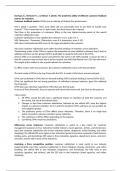De Haan, E., Verhoef, P. C., & Wiesel, T. (2015). The predictive ability of different customer feedback
metrics for retention.
Customer feedback metrics (CFMs) are an indicate of (future) firm performance.
CES is about 1 question, “How must effort did you personally have to put forth to handle your
request?”. This is measured on a 5 point scale. But there have to be a request.
Top-2-box is the proportion of customers filling in the two highest-scoring points of the overall
customer satisfaction scale.
Customer satisfaction is how satisfied the customer is on a scale of 1-7.
NPS: Detractors – Promotors. (Detractors: score 0-6, promotors: score 9-10).
NPS value: Untransformed NPS score (0-10 range) provided by the customer.
Top-2-box customer satisfaction score offers the best predictor of retention across industries.
Transforming scales of the CFMs to capture the proportion of most satisfied customers (top-2-box) or
splitting customers up into groups (NPS) is preferable to using the full scale of the CFMs.
CES has little to no predictive power and performs the worst of all CFMs studied. A reason for this is
that the customer may not have had a service request, but with that filtered out is CES also the worst.
The length of the relation is also a good indicator for retention.
In offline sectors with rare purchases, the customer satisfaction score is the best predictor.
The best combi of CFMs is the top-2-box with the CES. A combi of the future, present and past.
CFMs can be divided in CFMs that are forward looking (NPS) and back-looking & current CFMs (CES).
CFMs are significant but not strong predictors of individual customer behavior, given the relatively
low R-squares.
CFMs that uses extremes outperform CFMs that uses the full scale.
In terms of time dimension, focus on present and future both works well, but focus on the past not.
5 key results:
1. All CFMs, except the CES, have a significant impact on retention at both the customer and
firm levels, but not at the industry level.
2. Changes in top-2-box customer satisfaction, followed by the official NPS, have the highest
impact on customer retention. So it is useful to transform CFMs and focus on very positive (or
very negative) groups.
3. The predictive power of CFMs differs across industries. Therefore, there is no single best
metric to predict customer retention across industries.
4. The usefulness of CFMs differs depending on the purpose
5. Combining CFMs improves predictions.
Differences across industries: Customer satisfaction is useful as a key metric for customer
management purposes in four industries (mobile telecom, travel agencies, airlines, and electronics),
top-2-box customer satisfaction also in four industries (banks, drugstores, online booking, and online
shopping), the official NPS score again in four industries (general insurance companies, fixed telecom,
holiday parks, and furnishing), NPS value in three industries (gasoline, department stores, and do-it-
yourself), and the CES in none of the industries.
Analyzing a firms competitive position: customer satisfaction is most useful in one industry
(supermarkets), top-2-box customer satisfaction in three industries (energy, electronics, and online
booking), the official NPS in two industries (drugstores, and furnishing), the NPS value in two
industries (gasoline, and airlines), and the CES also in two industries (travel agencies, and online
shopping).
, De Haan, E., Verhoef, P.C. and Wiesel, T. (2021). Customer Feedback Metrics for Marketing
Accountability.
Accountable is the concept of taking responsibility for actions, decisions, and outcomes. (??)
Accountable marketing departments have a larger influence within the firm.
In order for marketing departments to become more accountable, the suggestion is to focus
on one overarching market asset, and to align with the finance department in choosing the relevant
metric(s) to track this asset.
One asset could be the customer base, measured through customer equity / CLV.
CLV and CE bridge the gap between finance, accounting and marketing, which is necessary to make
marketing more accountable, get more support and improve the influence of marketing departments.
CLV is the net present value of the future cash flows the firm expects to receive during a customer’s
relationship with the firm. This includes retention rates, gross margins and acquisition costs.
Customer feedback measures (CFMs) can be used to predict the future CLV.
CFMs are measures of consumers’ perceptions, attitudes, and intentions towards a firm,
collected with surveys or data-mining, often on a regular basis.
CFMs are good predictors of (future) customer behavior and (future) firm performance. CFMs are
also intermediate measures of marketing’s impact.
Classification of CFMs:
- Level (Market/category level – Brand level – Customer level)
o Market/category: product awareness and product attractiveness
o Brand: brand awareness, brand consideration, and brand liking
o Customer satisfaction, the NPS, and the CES
- Relation with performance measures
o Market growth, brand sales
- Time focus (past – present - future)
o Past: the CES, which focuses on service experiences in the past
o Present: customer satisfaction, which focuses on current attitudes
o Future: NPS, which focuses on the intention to recommend the firm in the future
- Measurement scale used to summarize (full scale – focus)
o Full: average customer satisfaction
o Focus: Top-2-box, NPS
- Amount of questions and type of questions
Customer decision journey model by McKinsey:
First, the 3
industry level
CFMs
(awareness,
positive
attitudes &
adoption intention) have to be positive for a consumer to
start with the initial consideration set.
After the first purchase, the customer level CFMs will start to kick in.
Finally, after a purchase with positive experiences, this can translate in advocacy in the customer
decision journey model, which can be measured with the NPS or loyalty intentions.





